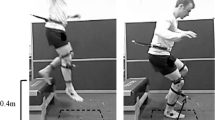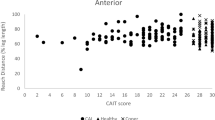Abstract
Purpose
To quantify the dynamic balance deficits that characterise a group with chronic ankle instability compared to lateral ankle sprain copers and non-injured controls using kinematic and kinetic outcomes.
Methods
Forty-two participants with chronic ankle instability and twenty-eight lateral ankle sprain copers were initially recruited within 2 weeks of sustaining a first-time, acute lateral ankle sprain and required to attend our laboratory 1 year later to complete the current study protocol. An additional group of non-injured individuals were also recruited to act as a control group. All participants completed the anterior, posterior-lateral and posterior-medial reach directions of the star excursion balance test. Sagittal plane kinematics of the lower extremity and associated fractal dimension of the centre of pressure path were also acquired.
Results
Participants with chronic ankle instability displayed poorer performance in the anterior, posterior-medial and posterior-lateral reach directions compared with controls bilaterally, and in the posterior-lateral direction compared with lateral ankle sprain copers on their ‘involved’ limb only. These performance deficits in the posterior-lateral and posterior-medial directions were associated with reduced flexion and dorsiflexion displacements at the hip, knee and ankle at the point of maximum reach, and coincided with reduced complexity of the centre of pressure path.
Conclusion
In comparison with lateral ankle sprain copers and controls, participants with chronic ankle instability were characterised by dynamic balance deficits as measured using the SEBT. This was attested to reduced sagittal plane motions at the hip, knee and ankle joints, and reduced capacity of the stance limb to avail of its supporting base.
Level of evidence
III.


Similar content being viewed by others
References
Anandacoomarasamy A, Barnsley L (2005) Long term outcomes of inversion ankle injuries. Br J Sports Med 39:e14; discussion e14
Brown C, Bowser B, Orellana A (2010) Dynamic postural stability in females with chronic ankle instability. Med Sci Sports Exerc 42:2258–2263
Davids K, Glazier P, Araújo D, Bartlett R (2003) Movement systems as dynamical systems: the functional role of variability and its implications for sports medicine. Sports Med 33:245–260
de Noronha M, Franca LC, Haupenthal A, Nunes GS (2012) Intrinsic predictive factors for ankle sprain in active university students: a prospective study. Scand J Med Sci Sports 23:541–547
Delahunt E, Coughlan GF, Caulfield B, Nightingale EJ, Lin CW, Hiller CE (2010) Inclusion criteria when investigating insufficiencies in chronic ankle instability. Med Sci Sports Exerc 42:2106–2121
Doherty C, Bleakley C, Hertel J, Caulfield B, Ryan J, Delahunt E (2015) Dynamic balance deficits 6-months following first-time acute lateral ankle sprain: a laboratory analysis. J Orthop Sports Phys Ther 45: 626–633
Doherty C, Bleakley C, Hertel J, Caulfield B, Ryan J, Delahunt E (2015) Laboratory measures of postural control during the star excursion balance test following acute ankle sprain. J Athl Train. doi:10.4085/1062-6050-50.1.09
Doherty C, Bleakley C, Hertel J, Caulfield B, Ryan J, Delahunt E (2014) Postural control strategies during single limb stance following acute lateral ankle sprain. Clin Biomech (Bristol Avon) 29:643–649
Glazier P, Davids K (2009) Constraints on the complete optimization of human motion. Sports Med 39:15–28
Gribble P, Delahunt E, Bleakley C, Caulfield B, Docherty C, Fourchet F et al (2013) Selection criteria for patients with chronic ankle instability in controlled research: a position statement of the international ankle consortium. J Orthop Sports Phys Ther 43:585–591
Gribble PA, Delahunt E, Bleakley C, Caulfield B, Docherty C, Fourchet F et al (2014) Selection criteria for patients with chronic ankle instability in controlled research: a position statement of the international ankle consortium. Br J Sports Med 48:1014–1018
Gribble PA, Delahunt E, Bleakley CM, Caulfield B, Docherty CL, Fong DTP et al (2014) Selection criteria for patients with chronic ankle instability in controlled research: a position statement of the international ankle consortium. J Athl Train 49:121–127
Gribble PA, Hertel J, Denegar CR (2007) Chronic ankle instability and fatigue create proximal joint alterations during performance of the star excursion balance test. Int J Sports Med 28:236–242
Gribble PA, Hertel J, Denegar CR, Buckley WE (2004) The effects of fatigue and chronic ankle instability on dynamic postural control. J Athl Train 39:321–329
Gribble PA, Hertel J, Plisky P (2012) Using the star excursion balance test to assess dynamic postural-control deficits and outcomes in lower extremity injury: a literature and systematic review. J Athl Train 47:339–357
Hertel J, Braham RA, Hale SA, Olmsted-Kramer LC (2006) Simplifying the star excursion balance test: analyses of subjects with and without chronic ankle instability. J Orthop Sports Phys Ther 36:131–137
Hertel J, Miller S, Denegar C (2000) Intratester and intertester reliability during the star excursion balance test. J Sport Rehabil 9:104–116
Hertel J, Olmsted-Kramer LC (2007) Deficits in time-to-boundary measures of postural control with chronic ankle instability. Gait Posture 25:33–39
Hoch M, Staton G, Medina McKeon J, Mattacola C, McKeon P (2012) Dorsiflexion and dynamic postural control deficits are present in those with chronic ankle instability. J Sci Med Sport 15:574–579
Hoch MC, Staton GS, McKeon PO (2011) Dorsiflexion range of motion significantly influences dynamic balance. J Sci Med Sport 14:90–92
Hopkins W, Marshall S, Batterham A, Hanin J (2009) Progressive statistics for studies in sports medicine and exercise science. Med Sci Sports Exerc 41:3–13
Hubbard TJ, Kramer LC, Denegar CR, Hertel J (2007) Contributing factors to chronic ankle instability. Foot Ankle Int 28:343–354
Huberty C, Morris J (1989) Multivariate analysis versus multiple univariate analyses. Psychol Bull 105:302–308
Katz MJ, George EB (1985) Fractals and the analysis of growth paths. Bull Math Biol 47:273–286
Kerkhoffs G, van den Bekerom M, Elders L, van Beek P, Hullegie W, Bloemers G et al (2012) Diagnosis, treatment and prevention of ankle sprains: an evidence-based clinical guideline. Br J Sports Med 46:854–860
McKeon PO, Hertel J (2008) Spatiotemporal postural control deficits are present in those with chronic ankle instability. BMC Musculoskelet Disord 9:76
Munn J, Sullivan S, Schneiders A (2010) Evidence of sensorimotor deficits in functional ankle instability: a systematic review with meta-analysis. J Sci Med Sport 13:2–12
Olmsted LC, Carcia CR, Hertel J, Shultz SJ (2002) Efficacy of the star excursion balance tests in detecting reach deficits in subjects with chronic ankle instability. J Athl Train 37:501–506
Plante J, Wikstrom E (2013) Differences in clinician-oriented outcomes among controls, copers, and chronic ankle instability groups. Phys Ther Sport 14:221–226
Plisky PJ, Rauh MJ, Kaminski TW, Underwood FB (2006) Star excursion balance test as a predictor of lower extremity injury in high school basketball players. J Orthop Sports Phys Ther 36:911–919
Prieto T, Myklebust J, Hoffmann R, Lovett E, Myklebust B (1996) Measures of postural steadiness: differences between healthy young and elderly adults. IEEE Trans Biomed Eng 43:956–966
Robinson R, Gribble P (2008) Kinematic predictors of performance on the star excursion balance test. J Sport Rehabil 17:347–357
Sefton JM, Hicks-Little CA, Hubbard TJ, Clemens MG, Yengo CM, Koceja DM et al (2009) Sensorimotor function as a predictor of chronic ankle instability. Clin Biomech (Bristol Avon) 24:451–458
Wikstrom EA, Brown C (2014) Minimum reporting standards for copers in chronic ankle instability research. Sports Med 44:251–268
Wikstrom EA, Fournier KA, McKeon PO (2010) Postural control differs between those with and without chronic ankle instability. Gait Posture 32:82–86
Wright C, Arnold B, Ross S, Linens S (2014) Recalibration and validation of the cumberland ankle instability tool cutoff score for individuals with chronic ankle instability. Arch Phys Med Rehabil 95:1853–1859
Acknowledgments
This study was supported by the Health Research Board (HRA_POR/2011/46). There were no conflicts of interest to report.
Author information
Authors and Affiliations
Corresponding author
Rights and permissions
About this article
Cite this article
Doherty, C., Bleakley, C., Hertel, J. et al. Dynamic balance deficits in individuals with chronic ankle instability compared to ankle sprain copers 1 year after a first-time lateral ankle sprain injury. Knee Surg Sports Traumatol Arthrosc 24, 1086–1095 (2016). https://doi.org/10.1007/s00167-015-3744-z
Received:
Accepted:
Published:
Issue Date:
DOI: https://doi.org/10.1007/s00167-015-3744-z




